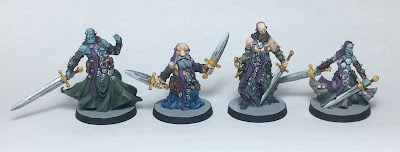I have written earlier this year about our Family Painting projects. Everybody in the family—all four boys, my wife, and I—works together to paint a set of board game miniatures. all of which came from the Arcadia Quest series: we have painted the core set, the Riders expansion, and the Beyond the Grave expansion. Everybody enjoyed it, and especially the youngest boy was eager for the next chance to paint together. Where could I go next? What figures did I have that would look better painted, despite the range of patience and skill of the painters?
How about 101 figures from Massive Darkness? Yes, that just might work.
I backed the original Massive Darkness campaign and enjoyed playing with my two older boys. More recently, we taught the third boy how to play, and he loved it. For those who are unfamiliar with the game, it's a bit like Diablo turned into a board game: throw a handful of dice to swing your mighty axe and watch the enemies fly off the board. It has received some criticism for its design, but we have always enjoyed it for what it is. Like a lot of people, I backed it in large part because it was a great deal to buy a bunch of beautiful D&D-style miniatures. The fact that we enjoyed the game is kind of icing on the cake.
Regular readers may recall that I painted the base set heroes and the Kickstarter extra heroes a few years ago. I still think that some of those heroes are among my best paint jobs. I have not painted any of the amazing monsters from the game, as something always gets in front of them. I wonder if I was playing more tabletop fantasy roleplaying games if that would incentivize me to beautify the monsters. In any case, the mobs are a foundational element of the game, though transient. You bring out a group of, say, Goblin Warriors, consisting of a mob boss and maybe six or twelve warriors. These warriors are essentially the hit points or health of the mob, each point of damage inflicted taking one off the table. They don't usually last very long, and the mob's boss is the last one to go. Over the course of the last several months, I have primed and mounted on corks all 101 of them, and over many sporadic sessions, we painted them all.
When we did the Arcadia Quest figures, I put the initials of each painter on the bottom, figuring that it would be fun to look back in a few years and see how skills improved. A lot of these figures were painted by individuals—the bosses in particular—but maybe half of them were painted by multiple people. My wife's style in particular was to keep applying paint while she had any in her palette, so if she had a good skin tone for dwarves, then she kept churning out dwarves. These ones, then, are not marked for who painted them: it's a product of the collective.
Without further ado and in no particular order, here they are! The bosses are all on the left of the photographs.
 |
| Goblin Warriors |
 |
| Goblin Archers |
 |
| Dwarf Warriors |
 |
| Troglodyte Warriors |
 |
| Orc Flayers |
 |
| Dwarf Defenders |
All together in imperfect lighting on my spare table, here they are!
 |
| 101 Cornets Close at Hand |
I don't think we were even done with the last figures of our last set before my youngest son (5) asked what we will be painting next for family painting. I explained that he could save up his allowance money to buy any kind of figure he wanted, and that I would be happy to sit with him and paint together that way. He was unimpressed.
I did actually just back Massive Darkness 2, despite some significant disagreement with parts of the artistic direction. Some of the figures look great, but I'm most excited about how it might breathe new life into this game that now we've all invested a lot of time into. Although the last thing I need in my office is more plastic, it will give us plenty more fodder for family painting as well, though I don't expect it to arrive until two years from now.
Incidentally, while the family was painting the mobs, I painted the agents. I was originally pretty excited about these four figures, starting with the Troglodyte Agent. The next day I woke up and had a funny realization: doesn't the dwarf figure also have the same kind of funny ear coverings as the Trog I just finished? I pulled out the card art for the dwarf... it's wearing basically exactly the same thing as the Troglodyte! Look at the Goblin and Orc... I had no idea, but they're all basically wearing the same thing, like some kind of bad-fashion cult. This took some of the wind out of my sails, and I figured I'd just batch-paint the other three. It turns out there are some tonal differences in them, and so they weren't as much of a let down as I had feared. I think the result is good, and of course, they will look better painted than not.
 |
| Orc, Dwarf, Troglodyte, and Goblin Agent |
Hm, that makes me really feel bad for some of the big bad villains. Unfortunately for them, they got pushed to the back burner yet again as I have started another board game set, but you'll have to come back another time to read about that.
Thanks for reading!

















